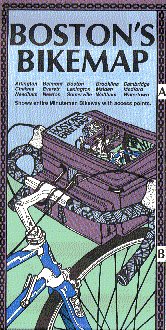My ideal bike map
 I think you’ll agree that the best driving route from Point A to Point B is not necessarily the best biking route. But when it comes down to characterizing just how good a particular road is for bicycling, things get complicated. While I’ve made good use of Rubel’s waterproof Boston Bikemap, my ideal bicycle map would give me answers to a whole slew of questions:
I think you’ll agree that the best driving route from Point A to Point B is not necessarily the best biking route. But when it comes down to characterizing just how good a particular road is for bicycling, things get complicated. While I’ve made good use of Rubel’s waterproof Boston Bikemap, my ideal bicycle map would give me answers to a whole slew of questions:
- How popular is the road with other bicycle commuters?
- What are the specific traffic dangers? Car doors? Alleys? Buses?
- How fast are the cars moving? How much traffic is there?
- How much space separates bicycle from auto traffic?
- Who/what else do bikers share this space with? Piles of debris and leaves?
- Has the road been the site of previous accidents?
- Is there a bike lane? Do drivers respect it?
- How smooth is the ride? Do you need to swerve frequently to avoid potholes?
- How well lit is the road after dark?
What would such a map look like? I’m not sure. I’ve run across attempts at one of these or another:
- Bikely lets users upload their own favorite routes, which can be searched by location.
- The Oregonian maps the frequency of where cars and bikes collide, and Transportation Alternatives collects data on NYC crashes by borough.
- Denis Wood mapped streetlights (sans streets) in his neighborhood
- Noah Vawter offers one approach to quantifying ride smoothness.
- byCycle’s Trip Planner colors streets based on traffic volume and speed.
- Cycle Path notes peak hour traffic and strategic shortcuts in their bicycle commuter map of Athens, Ohio
If you have others, please leave a comment. I’m very interested in leveraging technology to make bicycle commuting more approachable, safe, and enjoyable. A (cycle-specific) mapping and routing system affects all three, so it’s definitely on my radar.
UPDATE (2007.11.30): veloroutes, like bikely, let users share hand-drawn and GPS-generated routes. But neither of these, as far as I can tell, can directly answer my first question. I’d love to see a map that colors streets based on bicycle traffic volume.</p>
UPDATE (2007.12.03): Steve Spindler has posted some excellent comments below. Please take a look!</p>
